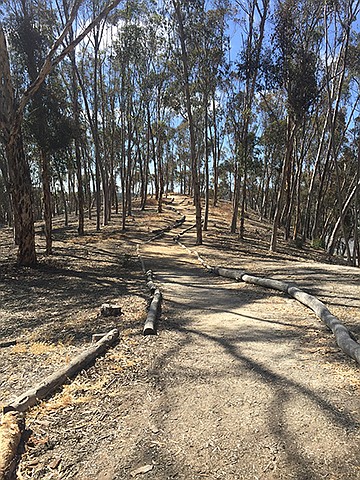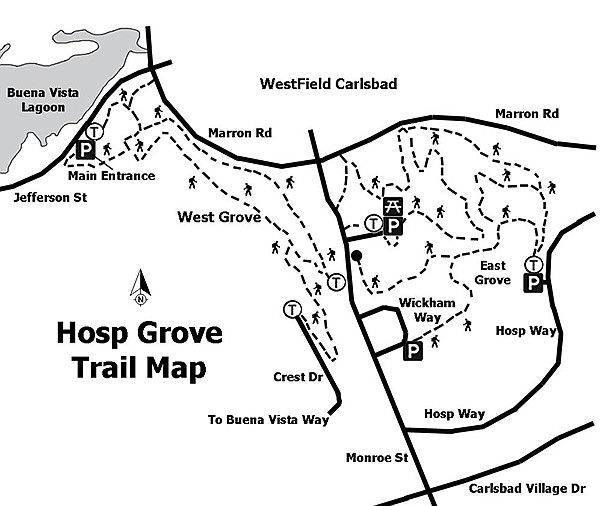 Facebook
Facebook
 X
X
 Instagram
Instagram
 TikTok
TikTok
 Youtube
Youtube

The dominant feature of Hosp Grove is the eucalyptus trees that were originally planted by F.P. Hosp in 1908. Believing that the fast-growing drought-tolerant Australian trees would be a great investment, he established the Hosp Eucalyptus Corp. and set about planting some 40,000 trees to sell to the expanding Santa Fe Railroad to make railroad ties. However, the idea went bust as it became clear that eucalyptus is not suited for construction — especially as railroad ties because the eucalyptus wood is brittle and unable to hold railroad spikes. Today, however, eucalyptus is used to make fence posts, paper pulp, and is distilled for its essential oils, which are used in perfumes and candles.
Fast-forward 78 years to 1986: the City of Carlsbad created Hosp Grove Park in remembrance of its heritage, putting aside 53 of the remaining original 219 acres of Hosp’s investment as a fabulous city park for biking, trail-running, walking the dog, or just taking a meditative stroll. Hosp Grove Park is a great destination anytime of year — especially on sunny summer days when seeking a bit of shade. The trails are the first city trails built and maintained by volunteers.
Quick rising slopes and an open canopy along with a large picnic area punctuate the east grove loop. Parking is just off Monroe St. and is unpaved. The main trail is well marked but bisected by several smaller trails that give runners and bikers plenty of variation for any outdoor excursion serving as a great workout. The 1.5-mile main loop is shaded by giant eucalyptus trees forming the only large hardwood forest in Carlsbad.

The west grove loop has one primary trail that is well marked and also about 1.5 miles long. This section of the park has a large paved parking area, children’s play equipment, and porta potties. Via a wooden pedestrian bridge, the trail leads visitors out of the parking area and into a thick canopy of eucalyptus. Along the trail, discover birds, squirrels, lizards, and a host of native Californian plants. The most abundant native plant along the west section of the park is lemonade berry (Rhus integrifolia). Other plants include coast prickly pear (Opuntia littoralis), flat-top buckwheat (Eriogonum fasciculatum), chalk dudleya (Dudleya pulverulenta), toyon (Heteromeles arbutifolia), redberry buckthorn (Rhamnus crocea), and mule-fat (Baccharis salicifolia).
A secret gem for bird enthusiasts, the west grove section overlooks the Buena Vista Lagoon Preserve and is the prefect lookout for local and migratory feathered visitors. A natural marvel of 350 acres, the lagoon is the only fresh-water lagoon left in California. Buena Vista preserve was established in 1969 and is part of the north-south Pacific Flyway that birds travel each year during spring and fall migrations, some flying some or all of the distance. White and brown pelicans and grebes are most often sighted in winter. Look for great blue heron, cormorants, ducks, and many other species that stop to take a dip or feed.

Distance from downtown San Diego: 40 miles. Allow 50 minutes driving time (Carlsbad). Take I-5 N, exit at Carlsbad Village Dr. Turn left at Monroe St., continue approximately 1 mile to the dirt parking lot and picnic area on the right for the Hosp Grove (East) trailhead. Another option is the Hosp Grove West with the distance from East Trailhead to West Trailhead parking approximately 1 mile. From Hosp Grove East, continue north on Monroe St. to Marron Rd. and turn left on Jefferson St. Continue on Jefferson St. for several hundred feet then turn left into the Hosp Grove West parking lot.
Hiking length: 1.5-mile loop, each section.
Difficulty: Moderate with elevation gain of about 300 feet. Both trails are open daily from sunrise to 10 p.m. for biking and hiking — pets are allowed but must be kept on leashes under six feet long.


The dominant feature of Hosp Grove is the eucalyptus trees that were originally planted by F.P. Hosp in 1908. Believing that the fast-growing drought-tolerant Australian trees would be a great investment, he established the Hosp Eucalyptus Corp. and set about planting some 40,000 trees to sell to the expanding Santa Fe Railroad to make railroad ties. However, the idea went bust as it became clear that eucalyptus is not suited for construction — especially as railroad ties because the eucalyptus wood is brittle and unable to hold railroad spikes. Today, however, eucalyptus is used to make fence posts, paper pulp, and is distilled for its essential oils, which are used in perfumes and candles.
Fast-forward 78 years to 1986: the City of Carlsbad created Hosp Grove Park in remembrance of its heritage, putting aside 53 of the remaining original 219 acres of Hosp’s investment as a fabulous city park for biking, trail-running, walking the dog, or just taking a meditative stroll. Hosp Grove Park is a great destination anytime of year — especially on sunny summer days when seeking a bit of shade. The trails are the first city trails built and maintained by volunteers.
Quick rising slopes and an open canopy along with a large picnic area punctuate the east grove loop. Parking is just off Monroe St. and is unpaved. The main trail is well marked but bisected by several smaller trails that give runners and bikers plenty of variation for any outdoor excursion serving as a great workout. The 1.5-mile main loop is shaded by giant eucalyptus trees forming the only large hardwood forest in Carlsbad.

The west grove loop has one primary trail that is well marked and also about 1.5 miles long. This section of the park has a large paved parking area, children’s play equipment, and porta potties. Via a wooden pedestrian bridge, the trail leads visitors out of the parking area and into a thick canopy of eucalyptus. Along the trail, discover birds, squirrels, lizards, and a host of native Californian plants. The most abundant native plant along the west section of the park is lemonade berry (Rhus integrifolia). Other plants include coast prickly pear (Opuntia littoralis), flat-top buckwheat (Eriogonum fasciculatum), chalk dudleya (Dudleya pulverulenta), toyon (Heteromeles arbutifolia), redberry buckthorn (Rhamnus crocea), and mule-fat (Baccharis salicifolia).
A secret gem for bird enthusiasts, the west grove section overlooks the Buena Vista Lagoon Preserve and is the prefect lookout for local and migratory feathered visitors. A natural marvel of 350 acres, the lagoon is the only fresh-water lagoon left in California. Buena Vista preserve was established in 1969 and is part of the north-south Pacific Flyway that birds travel each year during spring and fall migrations, some flying some or all of the distance. White and brown pelicans and grebes are most often sighted in winter. Look for great blue heron, cormorants, ducks, and many other species that stop to take a dip or feed.

Distance from downtown San Diego: 40 miles. Allow 50 minutes driving time (Carlsbad). Take I-5 N, exit at Carlsbad Village Dr. Turn left at Monroe St., continue approximately 1 mile to the dirt parking lot and picnic area on the right for the Hosp Grove (East) trailhead. Another option is the Hosp Grove West with the distance from East Trailhead to West Trailhead parking approximately 1 mile. From Hosp Grove East, continue north on Monroe St. to Marron Rd. and turn left on Jefferson St. Continue on Jefferson St. for several hundred feet then turn left into the Hosp Grove West parking lot.
Hiking length: 1.5-mile loop, each section.
Difficulty: Moderate with elevation gain of about 300 feet. Both trails are open daily from sunrise to 10 p.m. for biking and hiking — pets are allowed but must be kept on leashes under six feet long.
Comments